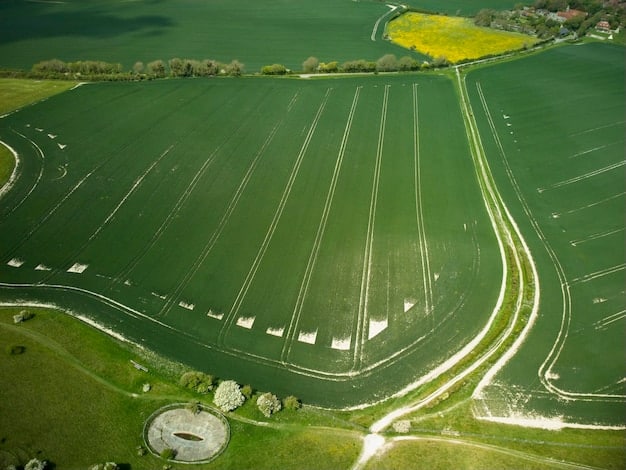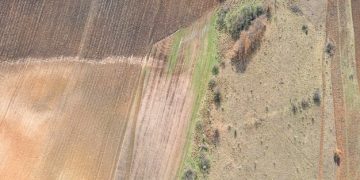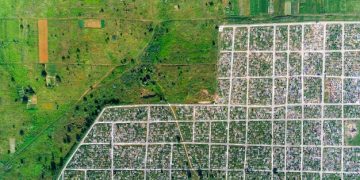US Farmers’ Guide: New Farm Bill Conservation Program Benefits

The new Farm Bill’s conservation programs offer substantial benefits to US farmers by providing financial assistance, technical support, and incentives for adopting sustainable practices that enhance environmental health, bolster farm resilience, and reduce long-term operational costs.
The agricultural landscape of the United States is continuously evolving, shaped by economic pressures, environmental concerns, and shifting policy priorities. For many farmers, navigating these complexities while maintaining profitability and stewardship of the land is a challenging balancing act. Amidst this intricate environment, understanding how US farmers can benefit from the new conservation programs in the Farm Bill becomes not just an advantage, but a critical necessity for sustainable and prosperous operations.
Understanding the Foundation: What is the Farm Bill?
The Farm Bill, a comprehensive piece of federal legislation, is arguably the most impactful policy for agriculture and food systems in the United States. It’s not merely a single law but a multi-year omnibus bill that dictates policy for commodity programs, trade, conservation, food and nutrition assistance, rural development, agricultural research, forestry, energy, horticulture, and crop insurance. This legislative behemoth is typically reauthorized every five years, undergoing extensive debate and negotiation to address the most pressing issues facing the nation’s farmers and consumers.
The bill’s influence extends far beyond the farm gate, touching every aspect of American life from the grocery store shelf to the quality of the nation’s waterways. Its conservation title, in particular, plays a pivotal role in shaping how agricultural lands are managed, aiming to balance productivity with environmental protection. These programs offer a variety of tools and incentives to farmers, encouraging them to adopt practices that conserve natural resources, improve soil health, enhance water quality, and protect biodiversity. The underlying philosophy is that healthy land leads to healthy farms and, ultimately, a healthier nation.
Historical Context and Evolution of Conservation
Conservation has been a foundational element of US agricultural policy since the Dust Bowl era of the 1930s. Early programs focused primarily on soil erosion control, reflecting the urgent need to address widespread land degradation. Over time, the scope of conservation policy has expanded significantly. It now encompasses a broader range of environmental concerns, including water quality, wetland protection, wildlife habitat, and climate change mitigation. This evolution reflects a growing scientific understanding of ecological systems and an increased societal awareness of the interconnectedness of agriculture and the environment. Each successive Farm Bill has refined and expanded these programs, aiming to make them more effective, accessible, and responsive to the evolving needs of farmers and the environment. This continuous adaptation ensures that the conservation provisions remain relevant and impactful in promoting sustainable agricultural practices across the nation.
Key Policy Shifts and Goals
The shifts in conservation policy within the Farm Bill reflect evolving national priorities and scientific understanding. Early iterations focused on direct payments for land retirement or specific erosion control measures. More recently, there has been a significant pivot towards performance-based incentives and comprehensive conservation planning.
* Shift to System-Based Approaches: Moving beyond individual practices to holistic farm management plans.
* Emphasis on Soil Health: Recognizing the fundamental importance of healthy soils for productivity and environmental benefits.
* Climate Resilience: Incorporating practices that help farms adapt to changing climate patterns and reduce greenhouse gas emissions.
* Voluntary Participation: Maintaining a strong emphasis on voluntary agreements, allowing farmers flexibility.
The overarching goal remains dual-pronged: to support a robust agricultural sector while simultaneously safeguarding and enhancing the nation’s natural resources. This balance is crucial for long-term sustainability.
The Role of Stakeholders
Developing the Farm Bill is a highly collaborative process involving numerous stakeholders. Farmers themselves, through various agricultural organizations, are key voices, advocating for programs that meet their operational needs. Environmental groups push for stronger conservation measures and greater environmental benefits. Academic institutions provide research and data that inform policy decisions, while government agencies like the USDA implement the final legislation and provide technical assistance. This complex interplay of interests ensures that the Farm Bill attempts to address a wide array of concerns, striving for a balance that supports both agricultural productivity and environmental stewardship. The iterative nature of the bill allows for adjustments and improvements based on feedback from these diverse groups, ensuring its continued relevance.
Core Conservation Programs in the New Farm Bill
The latest Farm Bill introduces a series of enhancements and increased funding to several cornerstone conservation programs, reflecting a renewed commitment to environmental stewardship within the agricultural sector. These programs are designed to provide a range of tools and incentives for farmers, empowering them to adopt practices that foster sustainability, improve natural resource health, and enhance the resilience of their operations. Understanding the nuances of each program is crucial for farmers seeking to leverage these opportunities.

Environmental Quality Incentives Program (EQIP)
The Environmental Quality Incentives Program (EQIP) remains one of the most popular and impactful programs under the conservation title. EQIP provides financial and technical assistance to agricultural producers to address natural resource concerns and deliver environmental benefits. It is a highly flexible program, allowing farmers to implement a wide array of conservation practices tailored to their specific farm and local environmental conditions. The program helps farmers plan and implement conservation practices on working lands, such as improving water and air quality, conserving ground and surface water, increasing soil health, and improving wildlife habitat. Funding through EQIP is allocated competitively, with applications ranked based on environmental benefit and cost-effectiveness. This ensures that taxpayer dollars are used efficiently to achieve significant conservation outcomes.
Benefits and Focus Areas of EQIP
EQIP’s design allows it to adapt to diverse agricultural operations, from row crop farms to livestock ranches. Farmers receive payments for implementing practices like:
* Cover Cropping: Enhancing soil health, reducing erosion, and sequestering carbon.
* No-Till/Reduced Tillage: Minimizing soil disturbance to improve soil structure, water infiltration, and reduce fuel consumption.
* Nutrient Management: Optimizing fertilizer application to prevent runoff and improve water quality.
* Rotational Grazing: Improving pasture health, promoting biodiversity, and increasing animal performance.
* Water Conservation: Implementing efficient irrigation systems to reduce water usage.
The program also provides technical assistance, connecting farmers with experts who can help design and implement their conservation plans. This holistic support ensures successful adoption and sustained benefits.
Conservation Stewardship Program (CSP)
The Conservation Stewardship Program (CSP) is unique in its approach, rewarding farmers for maintaining and improving existing conservation efforts while also encouraging them to adopt new, advanced conservation practices. Unlike EQIP, which focuses on specific practices to address a resource concern, CSP offers payments for the overall environmental benefits a producer achieves. It aims to build upon existing good stewardship practices, promoting a higher level of conservation. Farmers develop comprehensive conservation plans for their entire operation, which can include multiple practices and enhancements that go beyond minimum management requirements. This program is particularly beneficial for farmers who are already committed to conservation and are looking to push their sustainability efforts further, recognizing their long-term dedication to environmental health.
Enhancements and Rewards under CSP
The new Farm Bill strengthens CSP, offering greater incentives for higher levels of conservation. This includes:
* Enhanced Payments: Recognizing the value of complex and innovative conservation systems.
* Bundling of Practices: Encouraging farmers to combine multiple practices for cumulative benefits.
* Renewals: Providing options for producers to renew their CSP contracts, ensuring continuous improvement.
CSP also places a significant emphasis on measurable environmental outcomes, encouraging farmers to adopt practices that yield demonstrable benefits for soil, water, air, and wildlife. This focus on outcomes helps in tracking the long-term impact of the program.
Agricultural Conservation Easement Program (ACEP)
The Agricultural Conservation Easement Program (ACEP) provides financial and technical assistance to help conserve agricultural lands and wetlands. It consists of two primary components: Agricultural Land Easements (ALE) and Wetland Reserve Easements (WRE). ALE helps state and local governments and non-governmental organizations protect working agricultural lands by limiting non-agricultural uses through conservation easements, ensuring that valuable farmland remains available for food production. WRE helps landowners restore, protect, and enhance wetlands on their property, contributing to biodiversity, water quality, and flood control. ACEP is a critical tool for long-term conservation, ensuring that land with high agricultural value and environmental significance is permanently protected.
Long-Term Impact and Eligibility for ACEP
ACEP is designed for permanence, making it a strategic choice for landowners committed to lasting conservation. Eligibility generally depends on:
* Land Type: Productive agricultural land or wetlands with significant ecological value.
* Partner Organizations: For ALE, partnership with eligible entities like land trusts.
* Commitment: Willingness to place an easement on the land, restricting future development.
The program offers a powerful mechanism to preserve the agricultural heritage and natural ecosystems of the United States.
Financial and Technical Assistance Offered
One of the most appealing aspects of the new Farm Bill’s conservation programs for US farmers is the comprehensive nature of the support offered. It extends beyond mere financial incentives, encompassing crucial technical assistance that empowers farmers to make informed, effective decisions for their unique operations. This dual approach maximizes the likelihood of successful conservation implementation and sustained land stewardship.
Grants and Cost-Sharing Mechanisms
The primary financial benefit from these programs comes in the form of grants and cost-sharing agreements. Under programs like EQIP and CSP, farmers can receive direct payments or reimbursements for a significant portion of the costs associated with planning and implementing approved conservation practices. This financial relief can be a game-changer, especially for smaller farms or those operating on thin margins, effectively reducing the financial barrier to adopting sustainable methods. For example, installing a new, more efficient irrigation system or initiating a highly effective cover cropping regimen might be cost-prohibitive without this assistance. The cost-share rates vary, often covering between 50% to 75% of the total cost, with higher rates sometimes available for historically underserved producers, ensuring equitable access to these benefits. This substantial financial backing encourages broader participation in conservation efforts, translating directly into tangible environmental improvements across agricultural landscapes.
Breaking Down the Financial Support
Understanding how these funds are distributed is crucial for farmers planning to apply:
* Practice Payments: Direct payments for specific conservation practices, calculated based on typical costs.
* Enhancements (CSP): Additional payments for adopting bundles of conservation activities that yield higher levels of environmental benefits.
* Easement Payments (ACEP): Payments to landowners for placing permanent or long-term easements on their property.
These financial incentives are designed to make conservation an economically viable choice for all types of agricultural operations, fostering innovation and long-term commitment to sustainability.
Technical Support and Expert Guidance
Beyond financial aid, the technical assistance component is equally, if not more, valuable. The USDA’s Natural Resources Conservation Service (NRCS) provides a cadre of experts—conservationists, soil scientists, engineers, and wildlife biologists—who work directly with farmers. These professionals offer invaluable guidance, from conducting on-farm assessments to developing tailored conservation plans and even assisting with the application process. This technical support ensures that practices are implemented correctly and effectively, maximizing their environmental and economic benefits. For a farmer grappling with complex issues like nutrient management or wetland restoration, having access to specialized knowledge can be the difference between a failed attempt and a thriving success. This partnership approach empowers farmers, building their capacity to manage their land sustainably for generations to come.
Navigating the Application Process with Technical Help
Technical assistance is particularly vital during the often-complex application process for these programs. Experts provide:
* On-Site Assessments: Evaluating the specific natural resource concerns and opportunities on a farm.
* Conservation Planning: Helping farmers develop comprehensive plans that align with program goals.
* Application Submission: Guiding applicants through the paperwork and eligibility requirements.
* Implementation Support: Offering advice during the installation or adoption of new practices.
This hands-on support demystifies the process, making conservation programs accessible to a broader range of farmers, regardless of their prior experience with federal programs.
Long-Term Benefits for Farmers and the Environment
The significance of the new Farm Bill’s conservation programs extends far beyond immediate financial relief or the adoption of individual practices. They lay the groundwork for a more resilient, sustainable agricultural future, benefiting both the farming community and the broader environment. These long-term advantages underscore the strategic importance of engaging with these federal initiatives.
Enhanced Soil Health and Productivity
Perhaps the most fundamental long-term benefit of conservation practices centers on soil health. Practices like cover cropping, no-till farming, and diverse crop rotations, actively promoted by EQIP and CSP, lead to significant improvements in soil structure, organic matter content, and microbial activity. Healthier soil is more resilient to extreme weather events, holds water more efficiently, and reduces the need for expensive synthetic inputs like fertilizers. Over time, this translates into increased crop yields, reduced input costs, and greater overall farm profitability. For instance, studies have shown that farms transitioning to no-till practices can see reduced fuel and labor costs, while improved soil organic matter can enhance water infiltration by 5-10 times, mitigating drought impacts and reducing runoff. This investment in the land’s foundational resource pays dividends for decades.
Core Benefits of Improved Soil Health
The ripple effects of healthy soil are extensive, providing numerous advantages:
* Increased Water Infiltration: Reducing runoff and enhancing drought resilience.
* Improved Nutrient Cycling: Making nutrients more available to plants, potentially reducing fertilizer needs.
* Enhanced Soil Structure: Better aeration and root penetration, leading to stronger plants.
* Carbon Sequestration: Storing atmospheric carbon in soil, contributing to climate change mitigation.
These benefits collectively contribute to a more stable and productive farming system, safeguarding future yields.
Improved Water Quality and Conservation
Agriculture is intrinsically linked to water resources, both as a user and, at times, as a source of pollutants. Conservation programs play a crucial role in improving water quality by incentivizing practices that reduce nutrient runoff, sediment erosion, and pesticide leaching into waterways. Nutrient management plans, riparian buffers, and constructed wetlands help filter out contaminants before they reach streams, rivers, and groundwater. Furthermore, programs support the adoption of precision irrigation technologies that conserve water, ensuring its efficient use on the farm. Protecting water quality not only benefits the environment and public health but also preserves this vital resource for agricultural use, securing its availability for future generations of farmers. Minimizing water waste optimizes operational costs and enhances sustainability.
Water-Related Conservation Practices
Effective water management is a cornerstone of sustainable agriculture:
* Buffer Strips: Vegetated areas along waterways that filter runoff.
* Pest Management: Reduced reliance on chemical pesticides through integrated pest management.
* Wetland Restoration: Reestablishing natural filtration systems and wildlife habitat.
These practices demonstrate how targeted conservation efforts can deliver far-reaching environmental benefits beyond the farm boundary.
Enhanced Biodiversity and Wildlife Habitat
The promotion of diverse landscapes and natural ecosystems on farms is another key benefit. Conservation practices, such as creating habitat buffers, managing grazing lands, and restoring wetlands, provide vital refuge and resources for a wide array of wildlife, from pollinators and beneficial insects to birds and larger mammals. Increased biodiversity directly supports ecosystem services critical to agriculture, such as natural pest control and pollination, reducing the need for external inputs. This approach fosters a more balanced and resilient agricultural ecosystem, where nature plays an active role in supporting farm productivity. A thriving ecosystem on and around a farm can lead to healthier crops and livestock, contributing to overall farm integrity and creating new avenues for economic diversification.
Creating and Protecting Habitats on Farms
Farmers can engage in several practices to foster biodiversity:
* Pollinator Plantings: Establishing native plants that support bees and other pollinators.
* Conservation Cover: Planting permanent vegetative cover for general wildlife use.
* Forestry Management: Sustainable management of wooded areas on farm properties.
These initiatives support both the aesthetic and ecological value of farmland, creating a holistic approach to conservation.
Strategic Planning for Program Participation
Successfully leveraging the new Farm Bill’s conservation programs requires more than just knowing they exist; it demands a proactive and strategic approach to planning and engagement. Farmers who invest time in understanding the nuances of these programs and prepare thoroughly are best positioned to maximize their benefits.
Assessing Farm Needs and Goals
The first critical step for any farmer considering these programs is a thorough assessment of their own operation’s needs, challenges, and long-term goals. This involves looking beyond immediate issues and envisioning a sustainable future for the farm. Are there persistent soil erosion problems? Is water usage inefficient? Are input costs steadily rising? Understanding these underlying issues allows farmers to strategically identify which conservation practices are most relevant and beneficial. Furthermore, aligning conservation efforts with broader business objectives, such as increasing yield, reducing operating expenses, or diversifying revenue streams, can make the application process more focused and compelling. This self-assessment serves as the foundation for developing a coherent conservation plan.
Key Considerations for Self-Assessment
Before approaching the NRCS or other agencies, farmers should consider:
* Resource Concerns: Identify specific issues like soil erosion, water quality, or declining wildlife habitat.
* Operational Strengths/Weaknesses: Pinpoint areas where inefficiencies or environmental risks exist.
* Future Vision: Define long-term goals for the farm’s productivity, profitability, and environmental impact.
* Existing Practices: Catalog current conservation efforts that could be built upon.
This internal review helps narrow down the most suitable programs and practices that align with the farm’s unique context.
Connecting with Local NRCS and Extension Offices
Once a farmer has a clearer picture of their needs, the next indispensable step is to connect with their local Natural Resources Conservation Service (NRCS) office or Cooperative Extension office. These are the primary conduits for information, technical assistance, and application processing for most federal conservation programs. NRCS staff are experts in conservation planning and can provide tailored advice, help identify specific program eligibility, and guide farmers through the complex application process. Extension agents, often affiliated with land-grant universities, offer valuable research-based information and educational resources, complementing the NRCS’s technical expertise. Building a relationship with these local resources is crucial, as they can demystify the bureaucracy and provide ongoing support throughout the conservation journey.
Benefits of Local Engagement
Engaging with local offices provides several advantages:
* Personalized Advice: Tailored recommendations based on local climate, soil types, and farming systems.
* Application Support: Guidance through paperwork and program requirements, increasing application success rates.
* Community Networks: Connections to other farmers and local conservation initiatives.
* Up-to-Date Information: Access to the latest program updates, funding cycles, and application deadlines.
These direct connections are invaluable for successful program participation and informed decision-making.
The Application Process and Tips for Success
The application process for most conservation programs can be detailed, requiring significant documentation and planning. It typically involves
submitting an application, developing a conservation plan with NRCS personnel, and entering into a contract if approved. While the process can seem daunting, there are several tips that can significantly increase a farmer’s chances of success: thorough record-keeping of farm operations, clear articulation of environmental concerns, and a well-defined plan of proposed conservation practices. Being proactive, asking questions, and seeking clarification from NRCS staff throughout the process are vital. Additionally, demonstrating a clear commitment to conservation and understanding how proposed practices align with the program’s objectives can make an application stand out. Persistence and attention to detail are key virtues in navigating these federal opportunities.
Tips for a Successful Application
Maximizing the chances of approval requires a systematic approach:
* Start Early: Application periods can be competitive, so early preparation is key.
* Detail Your Plan: Clearly outline what practices you intend to implement and their expected benefits.
* Highlight Multi-Benefits: Emphasize how your proposed actions address multiple resource concerns.
* Seek Feedback: Review your application with NRCS staff before final submission.
* Be Patient: The review process can take time, but the long-term benefits are worth the wait.
Adhering to these tips can significantly streamline the application journey and improve outcomes.
Addressing Common Challenges and Misconceptions
Despite the substantial benefits offered by the new Farm Bill’s conservation programs, many farmers encounter hurdles or hold misconceptions that can deter their participation. Addressing these common challenges head-on is vital to ensure broader adoption and maximize the positive impact of these initiatives across the agricultural sector.
Bureaucracy and Paperwork
One of the most frequently cited challenges for farmers is the perceived bureaucracy and extensive paperwork associated with federal programs. The application processes can indeed be detailed, requiring a significant investment of time and attention to detail. This can be particularly daunting for farmers already juggling numerous responsibilities. However, it’s crucial to understand that ample support is available. The Natural Resources Conservation Service (NRCS) staff are explicitly tasked with assisting farmers through every step of the process, from initial inquiry to final approval and implementation. They can help farmers understand the forms, compile necessary documentation, and ensure all requirements are met. Viewing the paperwork as a necessary investment in long-term farm health and profitability, rather than an insurmountable barrier, can shift perspectives. Embracing the support offered by NRCS can transform a seemingly complex undertaking into a manageable process, unlocking significant benefits.
Strategies for Navigating Paperwork
Simplifying the administrative load requires a proactive approach:
* Leverage NRCS Experts: Their primary role is to guide you through the forms and requirements.
* Organize Documents: Keep all farm records, maps, and land deeds readily accessible.
* Utilize Available Tools: Some agencies offer online portals or checklists to streamline submissions.
* Start Small: For new applicants, consider a straightforward project first to build familiarity with the process.
These strategies can help demystify the administrative aspects of program participation.
Perceived Loss of Control or Flexibility
Another common misconception is that participating in conservation programs means sacrificing control over one’s land or being subjected to rigid, top-down directives. While programs do involve contractual agreements and adherence to specific conservation plans, they are largely designed to be flexible and voluntary. The NRCS works collaboratively with farmers to develop tailored conservation plans that fit their unique operations, objectives, and local conditions. Farmers retain significant flexibility in how they achieve defined conservation outcomes, and the plans are often adaptable to changing circumstances. The goal is to enhance, not dictate, agricultural practices, fostering a partnership where farmers implement sustainable solutions that work for their specific context. This collaborative spirit ensures that conservation is a shared endeavor, respecting the farmer’s expertise and autonomy.
Addressing Concerns About Flexibility
Understanding the program’s design can alleviate concerns:
* Customized Plans: Conservation plans are developed in partnership with the farmer, not imposed.
* Voluntary Participation: Farmers choose whether and how to engage, maintaining autonomy.
* Adaptability: Plans can often be modified to account for changing farm conditions or goals.
* Focus on Outcomes: Programs often prioritize environmental outcomes, allowing flexibility in practice selection.
This partnership-based approach is fundamental to increasing farmer buy-in and long-term success.
Balancing Immediate Needs with Long-Term Goals
For many farmers, the immediate financial pressures of day-to-day operations can overshadow the long-term benefits of conservation. Investing in sustainable practices often requires an initial outlay of time, labor, or capital, even with cost-share assistance. This can be a tough sell when facing fluctuating commodity prices, unpredictable weather, or rising input costs. However, the conservation programs are specifically designed to bridge this gap, providing the financial incentives that make these long-term investments feasible. By mitigating the upfront costs and demonstrating measurable returns in terms of improved soil health, reduced input needs, and increased resilience, these programs help farmers see conservation as a crucial component of their overall business strategy rather than a luxury. It’s about building a more secure and profitable future for the farm.
Integrating Conservation into Business Strategy
Viewing conservation as an integral part of business planning can yield significant returns:
* Cost Savings: Reduced fertilizer, pesticide, fuel, and water usage over time.
* Risk Mitigation: Enhanced resilience to droughts, floods, and pest outbreaks.
* Market Advantages: Growing consumer demand for sustainably produced goods.
* Land Value: Increased long-term value of healthy, productive land.
These benefits demonstrate that conservation is not just an environmental imperative but a sound economic decision.
| Key Benefit | Brief Description |
|---|---|
| 💰 Financial Aid | Grants and cost-sharing reduce the financial burden of adopting sustainable practices. |
| 🌿 Improved Soil Health | Practices boost fertility, water retention, and productivity for long-term yields. |
| 💧 Enhanced Water Quality | Reduces runoff and conserves water through efficient irrigation and natural filters. |
| 🧑🔧 Technical Expertise | Access to NRCS specialists for tailored conservation plans and implementation support. |
Frequently Asked Questions About Farm Bill Conservation Programs
▼
The main objective is to help farmers implement conservation efforts on their land. This enhances natural resources, improves environmental quality, and supports sustainable agricultural production. The programs provide both financial aid and technical assistance to achieve these goals, benefiting both farmers and the broader ecosystem.
▼
EQIP (Environmental Quality Incentives Program) focuses on helping farmers address specific resource concerns by implementing new conservation practices. CSP (Conservation Stewardship Program), conversely, rewards farmers for maintaining existing high levels of conservation and adopting advanced stewardship activities across their entire operation, promoting comprehensive environmental benefits.
▼
Long-term environmental benefits include improved soil health and fertility, enhanced water quality through reduced runoff and efficient use, increased biodiversity, and the creation of healthier wildlife habitats. These outcomes contribute to greater ecosystem resilience and carbon sequestration, mitigating climate change impacts and supporting sustainable agriculture for future generations.
▼
Absolutely. Conservation programs are designed to be inclusive and benefit farms of all sizes, including small operations. Many programs offer higher cost-share rates and specific funding pools for historically underserved producers, which often include small and beginning farmers. Local NRCS offices provide tailored technical assistance to help small farms apply.
▼
The initial step is to contact your local Natural Resources Conservation Service (NRCS) office. NRCS staff can provide information on available programs, assess your farm’s specific needs, offer technical assistance for developing a conservation plan, and guide you through the application process. This personalized guidance is crucial for successful participation.
Conclusion
The new Farm Bill represents a significant opportunity for US farmers to embrace and expand their conservation efforts. By understanding and strategically participating in programs like EQIP, CSP, and ACEP, farmers can access vital financial and technical support that not only enhances environmental stewardship but also directly contributes to the long-term profitability and resilience of their operations. The commitment to soil health, water quality, and biodiversity embedded within these programs offers a pathway to a more sustainable and prosperous agricultural future, proving that good environmental practices are, in fact, good business practices.





